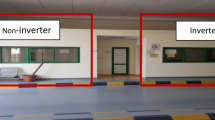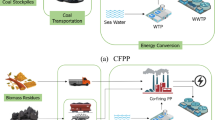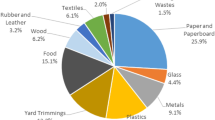Abstract
Switching from conventional mining to mass production technology is the need of the hour to meet the ever-increasing coal demand of the country. Consequently, today's focus is primarily on mine planning for successful implementation of mass production technology in Indian coal mines. As per existing norms, i.e., Coal Mines Regulations No. 153 sub clause 2 (a) of CMR 2017, to secure adequate ventilation in every ventilating district, not less than 6 m3 per minute of air per person employed in the district on the largest shift or not less than 2.5 m3 per minute of air per ton of daily output, whichever is larger, passes along the last ventilation connection (LVC) of the district. To comply with this rule, a large quantity of air is to be delivered in the LVC of the mass-production panels (MPPs), as the daily output of coal in the MPPs is very high. This large air quantity will generate excessive dust in the LVC panel as well as high water gauge will be developed in the main mechanical ventilator. This high ventilation pressure will accelerate the chances of spontaneous heating and endanger the overall safety of the mines. In this research, an attempt has been made to assess the optimum requirement of air for MPPs in Indian coal mines keeping minimum air velocity, and maintaining the dust, temperature and inflammable gas concentration within permissible limits. The parameters which have been considered in this research include respirable airborne dust concentration, temperature due to heat emission from machines, heat and humidity conditions and noxious and inflammable gas concentration existing in MPPs. Workable solutions have been derived for the calculation of optimum air requirement in continuous miner panels on the basis of respirable dust concentration and heat emission from machines. This study may be an eye opener for revamping the guidelines on ventilation air requirement for MPPs in Indian coal mines.

Similar content being viewed by others
References
Coal Mines Regulations, Ministry of labour and employment Government of India (2017)
J. Brodny, M. Tutak, Analysis of methane hazard conditions in mine headings. The. Vjesn. Tech. Gaz. 25, 271–276 (2018)
M. Branny, Computer simulation of flow of air and methane mixture in the longwall-return crossing zone. Arch. Min. Sci. 51, 133–145 (2006)
D. Felka, J. Brodny, Application of neural-fuzzy system in prediction of methane hazard. Int. Conf. Intell. Syst. Prod. Eng. Maint. (2018). https://doi.org/10.1007/978-3-319-64465-3_15
Report of Investigation, Fatal Underground Mine Explosion April 5, 2010, vol. 11. West Virginia: Naoma, WV, USA (2018)
Brodny J. Determination of the zone endangered by methane explosion in goaf with caving of operating longwalls. Int. Multidiscip. Sci. GeoConference SGEM, vol. 2, Surveying Geology & Mining Ecology Management (SGEM) (2016), pp. 299–306. https://doi.org/10.5593/SGEM2016/B12/S03.039
Tragedy Report to the Governor General, Royal Commission on the Pike River Coal Mine Wellington. Wellington, (2012)
C.Ö. Karacan, F.A. Ruiz, M. Cotè, S. Phipps, Coal mine methane: a review of capture and utilization practices with benefits to mining safety and to greenhouse gas reduction. Int. J. Coal. Geol. 86, 121–156 (2011). https://doi.org/10.1016/j.coal.2011.02.009
D.P. Mishra, D.C. Panigrahi, P. Kumar, Computational investigation on effects of geo-mining parameters on layering and dispersion of methane in underground coal mines–a case study of moonidih colliery. J. Nat. Gas. Sci. Eng. 53, 110–124 (2018). https://doi.org/10.1016/j.jngse.2018.02.030
H.L. Hartman, J.M. Mutmansky, R.V. Ramani, Y.J. Wang, Mine Ventilation and Air Conditioning (Wiley, 2012)
B. Paluchamy, D.P. Mishra, D.C. Panigrahi, Airborne respirable dust in fully mechanised underground metalliferous mines – Generation, health impacts and control measures for cleaner production. J. Clean. Prod. 296, 126524 (2021). https://doi.org/10.1016/j.jclepro.2021.126524
B. Paluchamy, D.P. Mishra, Airborne dust generation and dispersion profiles due to loaded LPDT haulage in decline of a highly mechanized underground lead–zinc ore mine. Environ. Technol. Innov. 24, 101908 (2021). https://doi.org/10.1016/j.eti.2021.101908
G.B. Misra, Mine Environment and Ventilation (Oxford University Press, 1986)
National Academies of Sciences and Medicine E, Monitoring and Sampling Approaches to Assess Underground Coal Mine Dust Exposures (National Academies Press, 2018)
J.F. Colinet, J.P. Rider, J.M. Listak, J.A. Organiscak, A.L. Wolfe, Best Practices for Dust Control in Coal Mining, Information Circular 9517 (Natl Inst Occup Saf Heal (NIOSH), Pittsburgh, 2010), p. 84
A.P. Sasmito, E. Birgersson, H.C. Ly, A.S. Mujumdar, Some approaches to improve ventilation system in underground coal mines environment - A computational fluid dynamic study. Tunn. Undergr. Sp. Technol. 34, 82–95 (2013). https://doi.org/10.1016/j.tust.2012.09.006
M.J. Howes, Ventilation and cooling in underground mines. Min. Quarr. 74, 45–46 (2011)
H.N. Dougherty, Ventilation Airflow Around a Continuous Miner and Its Effect on Methane Concentrations at the Face (West Virginia University, New York, 2014)
Electrical Machines by D.P. Kothari, I.J. Nagrath, Chapter 9 Para 9
M. Sunkpal, P. Roghanchi, K.C. Kocsis, A method to protect mine workers in hot and humid environments. Saf. Health Work 9, 149–158 (2018). https://doi.org/10.1016/j.shaw.2017.06.011
L. Yueze, S. Akhtar, A.P. Sasmito, J.C. Kurnia, Prediction of air flow, methane, and coal dust dispersion in a room and pillar mining face. Int. J. Min. Sci. Technol. 27, 657–662 (2017). https://doi.org/10.1016/j.ijmst.2017.05.019
GasAlertMicro 5 Series | Honeywell https://sps.honeywell.com › products › safety › portables GasAlertMicro 5 IR portable gas detector simultaneously monitors up to five atmospheric hazards including carbon dioxide (CO2), oxygen (O2), combustible gas
Acknowledgements
The authors are very grateful to Coal India Limited and all the mines management for their cooperation and assistance in conducting the field surveys. The authors are also grateful to the suppliers of CM and PSLW sets for sharing the details of their machines.
Funding
The authors declare that no funds, grants, or other support were received during the preparation of this manuscript.
Author information
Authors and Affiliations
Corresponding author
Ethics declarations
Conflict of interest
The authors have no relevant financial or non-financial interests to disclose.
Additional information
Publisher's Note
Springer Nature remains neutral with regard to jurisdictional claims in published maps and institutional affiliations.
Rights and permissions
About this article
Cite this article
Das, K., Mishra, D.P. & Bhattacharjee, R.M. Ventilation Air Requirement for Mass-Production Panels (MPPs) in Indian Coal Mines: A Critical Appraisal. J. Inst. Eng. India Ser. D 104, 359–371 (2023). https://doi.org/10.1007/s40033-022-00371-9
Received:
Accepted:
Published:
Issue Date:
DOI: https://doi.org/10.1007/s40033-022-00371-9




